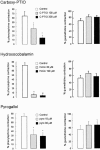Effects of agents that inactivate free radical NO (NO*) on nitroxyl anion-mediated relaxations, and on the detection of NO* released from the nitroxyl anion donor Angeli's salt
- PMID: 11588105
- PMCID: PMC1572981
- DOI: 10.1038/sj.bjp.0704287
Effects of agents that inactivate free radical NO (NO*) on nitroxyl anion-mediated relaxations, and on the detection of NO* released from the nitroxyl anion donor Angeli's salt
Abstract
1. The effects of agents that inactivate free radical nitric oxide (carboxy-PTIO, hydroxocobalamin and pyrogallol) were tested on relaxations produced by the nitroxyl anion (NO(-)) donor Angeli's salt in rat aortic rings and anococcygeus muscles. The amount of NO(*) generated from Angeli's salt in the presence of these agents was measured using a NO(*)-selective electrode sensor. 2. Carboxy-PTIO (100, 300 microM), hydroxocobalamin (30, 100 microM) and pyrogallol (10, 30 microM) significantly reduced relaxations produced by Angeli's salt (0.3 microM) in aortic rings but not in anococcygeus muscles. 3. NO(*) generated from Angeli's salt (0.1 - 10 microM), as detected by the sensor electrode, was less than 0.5% of the amount of Angeli's salt added. Carboxy-PTIO (100 microM) and hydroxocobalamin (30 microM), but not pyrogallol significantly increased the amount of NO(*) detected. 4. In the presence of an oxidizing agent copper [II] (as CuSO(4) 100 microM), the amount of NO(*) detected from 0.3 microM of Angeli's salt increased from an undetectable level of 142.7+/-15.7 nM (equivalent to 47.6% of Angeli's salt added). Under these conditions, carboxy-PTIO, hydroxocobalamin and pyrogallol significantly reduced the amount of NO(*) detected from Angeli's salt as well as the signal generated by an equivalent amount of authentic NO (0.33 microM). 5. The difference in effects of these agents on relaxations to Angeli's salt in the aorta and the anococcygeus muscle may be explained by the ready conversion of NO(-) to NO(*) in the aorta through an unidentified mechanism, which makes NO(-) susceptible to inactivation by these agents. Furthermore, in addition to inactivating NO(*), carboxy-PTIO and hydroxocobalamin may themselves oxidize NO(-) to NO(*), albeit slightly.
Figures





Similar articles
-
Comparison of the redox forms of nitrogen monoxide with the nitrergic transmitter in the rat anococcygeus muscle.Br J Pharmacol. 1999 Jun;127(4):826-34. doi: 10.1038/sj.bjp.0702540. Br J Pharmacol. 1999. PMID: 10433488 Free PMC article.
-
Formation of nitric oxide from nitroxyl anion: role of quinones and ferricytochrome c.Br J Pharmacol. 2001 Jan;132(1):165-72. doi: 10.1038/sj.bjp.0703812. Br J Pharmacol. 2001. PMID: 11156574 Free PMC article.
-
Differential actions of L-cysteine on responses to nitric oxide, nitroxyl anions and EDRF in the rat aorta.Br J Pharmacol. 2000 Jan;129(2):315-22. doi: 10.1038/sj.bjp.0703058. Br J Pharmacol. 2000. PMID: 10694238 Free PMC article.
-
The nitroxyl anion (HNO) is a potent dilator of rat coronary vasculature.Cardiovasc Res. 2007 Feb 1;73(3):587-96. doi: 10.1016/j.cardiores.2006.11.018. Epub 2006 Nov 18. Cardiovasc Res. 2007. PMID: 17189622
-
[Role of nitroxyl hydrogen on normal and failing heart].Zhonghua Xin Xue Guan Bing Za Zhi. 2008 Aug;36(8):759-60. Zhonghua Xin Xue Guan Bing Za Zhi. 2008. PMID: 19100124 Review. Chinese. No abstract available.
Cited by
-
The effects of nitroxyl (HNO) on soluble guanylate cyclase activity: interactions at ferrous heme and cysteine thiols.J Biol Chem. 2009 Aug 14;284(33):21788-21796. doi: 10.1074/jbc.M109.014282. Epub 2009 Jun 15. J Biol Chem. 2009. PMID: 19531488 Free PMC article.
-
Isotopic signatures of N2O produced by ammonia-oxidizing archaea from soils.ISME J. 2014 May;8(5):1115-25. doi: 10.1038/ismej.2013.205. Epub 2013 Nov 14. ISME J. 2014. PMID: 24225887 Free PMC article.
-
Influence of antioxidant depletion on nitrergic relaxation in the pig gastric fundus.Br J Pharmacol. 2002 Feb;135(4):917-26. doi: 10.1038/sj.bjp.0704553. Br J Pharmacol. 2002. PMID: 11861319 Free PMC article.
-
The specificity of nitroxyl chemistry is unique among nitrogen oxides in biological systems.Antioxid Redox Signal. 2011 May 1;14(9):1659-74. doi: 10.1089/ars.2010.3841. Epub 2011 Mar 16. Antioxid Redox Signal. 2011. PMID: 21235346 Free PMC article. Review.
-
NONO2P, a novel nitric oxide donor, causes vasorelaxation through NO/sGC/PKG pathway, K+ channels opening and SERCA activation.Eur J Pharmacol. 2024 Sep 15;979:176822. doi: 10.1016/j.ejphar.2024.176822. Epub 2024 Jul 22. Eur J Pharmacol. 2024. PMID: 39047965
References
-
- ADAK S., WANG Q., STUEHR D.J. Arginine conversion to nitroxide by tetrahydrobiopterin-free neuronal nitric oxide synthase. Implications for mechanism. J. Biol. Chem. 2000;275:33554–33561. - PubMed
-
- AKAIKE T., YOSHIDA M., MIYAMOTO Y., SATO K., KOHNO M., SASAMOTO K., MIYAZAKI K., UEDA S., MAEDA H. Antagonistic action of imidazolineoxyl N-oxides against endothelium-derived relaxing factors/nitric oxide through a radical reaction. Biochemistry. 1993;32:827–832. - PubMed
-
- ARNELLE D.R., STAMLER J.S. NO+, NO, NO− donation by S-nitrosothiols: implications for regulation of physiological functions by S-nitrosylation and acceleration of disulfide formation. Arch. Biochem. Biophys. 1995;318:279–285. - PubMed
-
- BARBIER A.J.M., LEFEBVRE R.A. Effect of LY 83583 on relaxation induced by non-adrenergic non-cholinergic nerve stimulation and exogenous nitric oxide in the rat gastric fundus. Eur. J. Pharmacol. 1992;219:331–334. - PubMed
Publication types
MeSH terms
Substances
LinkOut - more resources
Full Text Sources
Medical

